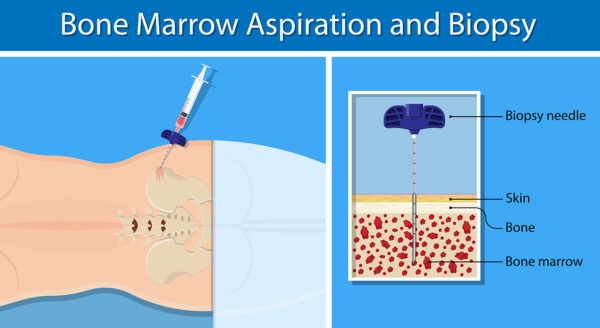Do Repeat Bone Marrow Aspiration Procedures Deplete The Marrow?

Rumruay/Shutterstock
One of the things we do at Regenexx is research to improve the field. Sometimes it’s a big clinical study and sometimes it’s looking at the small things that may make a difference in the efficacy of the procedures we offer. Today we’ll investigate whether multiple bone marrow aspiration procedures deplete the bone marrow of cells. Let’s dig in.
Bone Marrow Aspiration
Every bone marrow concentrate procedure begins with an aspiration of the bone marrow. The doctor uses a specialized needle called a trocar that’s usually placed in the back part of the pelvis near the PSIS. Most people think of bone like it’s cement, but it’s actually more like plastic, so a needle can be worked through it. The reason this is done is that the bone marrow is rich in stem and other cells. The aspirate looks like thick blood and then this is centrifuged to create bone marrow concentrate, which distills the stem cell fraction.
Repeated BMAs
Sometimes patients need either several bone marrow stem cell procedures in a row or they may need one knee procedure performed today and the second a few months from now. When this happens, the doctor has to go back to draw the same area in the pelvis several times. Does this deplete that spot of total cells? Is that specific to a certain age or gender?
This is the research question we set out to answer. My big concern was that in post-menopausal women there may be an issue. What did we find?
The Data

Here we looked at the total nucleated cell count (TNCC) of patients who had first and second bone marrow draws within 6 months. We segregated the patients into 4 groups:
- Females under 50
- Males under 50
- Females over 50
- Males over 50
The darker gey bar is the first draw and the lighter is the second draw. The lines represent the mean TNCC counts per ml. The only significant drop we saw was in women over 50. Meaning in only that group were there fewer cells at that spot for the second bone marrow draw.
Does This Make Sense?
Given that women over 50 have issues with osteoporosis that are related to hormonal influences on bone marrow stem cells, it’s not surprising that we see these issues with repeated bone marrow draws. However, what we don’t see is that older women have poorer results from first procedures. We’ve looked at that multiple times in multiple body parts and have never seen that association.
Hence, this is a guidepost for how to handle older women patients that need more than one procedure but doesn’t apply to women who need only one procedure
How Can We Adapt to These Findings?
We can easily get around these issues in older women by alternating the bone marrow draw technique. For example, using two different ways to perform the draw so that different areas are accessed each time, so we’re not taking cells from the same exact spot.
When the Little Things Make a Big Difference
With regenerative medicine, the little things make a big difference. For example, several years ago we published a paper on how using the wrong anesthetic could kill stem cells. While most clinics have gotten the message, we still have clinics using the wrong medications that kill cells.
The upshot? Doing this research costs money, but it’s the right thing to do. Why? Because there are dozens of little projects like this that need to be done to improve the results of these procedures.

NOTE: This blog post provides general information to help the reader better understand regenerative medicine, musculoskeletal health, and related subjects. All content provided in this blog, website, or any linked materials, including text, graphics, images, patient profiles, outcomes, and information, are not intended and should not be considered or used as a substitute for medical advice, diagnosis, or treatment. Please always consult with a professional and certified healthcare provider to discuss if a treatment is right for you.
